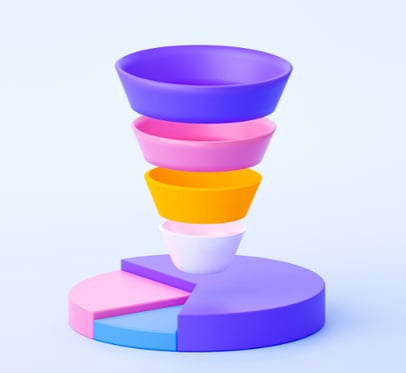Understanding the Customer Journey: How to Build a Marketing Funnel
In the fast-paced world of digital marketing, understanding the customer journey and effectively guiding potential customers through the stages of a marketing funnel is crucial for achieving business success. A well-designed marketing funnel helps you convert leads into loyal customers by nurturing them through each stage of their journey. In this blog, we'll dive into the key stages of a marketing funnel and provide actionable tips on how to use various digital channels to optimize each phase.
Amy Ellis
9/13/20242 min read
What is a Marketing Funnel?
A marketing funnel is a visual representation of the customer journey, illustrating the steps a potential customer takes from first becoming aware of your brand to making a purchase and beyond. The funnel metaphor helps marketers visualize the process of attracting, engaging, and converting leads.
The Stages of a Marketing Funnel
Awareness
Objective: Capture the attention of potential customers who are unaware of your brand or products.
Strategies:
Content Marketing: Create engaging blog posts, infographics, and videos that address the pain points and interests of your target audience. For example, if you sell eco-friendly products, write articles about the benefits of sustainable living.
Social Media: Use platforms like Facebook, Instagram, and LinkedIn to share content, engage with followers, and run targeted ads. Leverage hashtags and social media influencers to expand your reach.
SEO: Optimize your website and content for search engines to increase organic traffic. Focus on relevant keywords and create high-quality, shareable content.
Interest
Objective: Build interest and provide value to potential customers who have engaged with your brand.
Strategies:
Lead Magnets: Offer free resources like eBooks, PDFs, or webinars in exchange for contact information. This helps you gather leads and provide value early in the customer journey.
Email Marketing: Nurture leads with personalized email campaigns. Share relevant content, special offers, and updates to keep your audience engaged.
Retargeting Ads: Use retargeting to remind visitors who have shown interest in your products but haven’t converted yet. Display ads that highlight the benefits and features of your offerings.
Consideration
Objective: Encourage potential customers to evaluate your products or services and consider making a purchase.
Strategies:
Product Demos and Trials: Offer free trials or product demonstrations to showcase the value of your offerings. This helps potential customers experience your product firsthand.
Case Studies and Testimonials: Share success stories and testimonials from satisfied customers to build credibility and trust. Highlight how your product or service has solved real problems.
Comparison Guides: Create comparison guides that position your product against competitors. Clearly outline the benefits and unique selling points.
Conversion
Objective: Drive the final purchase decision and turn leads into paying customers.
Strategies:
Optimized Landing Pages: Design landing pages with clear calls-to-action (CTAs) and a streamlined user experience. Ensure the page is aligned with the messaging from your ads or emails.
Sales Promotions: Offer limited-time discounts, special offers, or bonuses to encourage immediate purchases. Use urgency and scarcity to drive action.
Easy Checkout Process: Simplify the checkout process to minimize friction. Ensure it’s mobile-friendly, secure, and easy to navigate.
Retention
Objective: Keep customers engaged and encourage repeat purchases.
Strategies:
Customer Loyalty Programs: Implement loyalty programs to reward repeat customers with discounts, points, or exclusive offers.
Follow-Up Emails: Send personalized follow-up emails to thank customers for their purchase, request feedback, and offer related products or services.
Excellent Customer Service: Provide exceptional customer support to address any issues and build long-term relationships.
Advocacy
Objective: Turn satisfied customers into brand advocates who refer others.
Strategies:
Referral Programs: Encourage satisfied customers to refer friends and family by offering incentives or rewards for successful referrals.
User-Generated Content: Promote and share content created by customers, such as reviews, testimonials, and social media posts featuring your products.
Engage with Your Community: Build a strong online community where customers can connect, share experiences, and support each other.
Conclusion
Building a successful marketing funnel involves understanding and addressing each stage of the customer journey. By strategically using digital channels and implementing effective strategies, you can guide leads from awareness to conversion, and beyond. Continuously analyze and optimize your funnel to improve performance and achieve your marketing goals.
Ready to build your marketing funnel? Start by mapping out your customer journey and implementing these strategies to drive results and grow your business.


The Journey Begins
Driving growth through strategic digital marketing solutions.
Make an impact
© 2024. All rights reserved.
